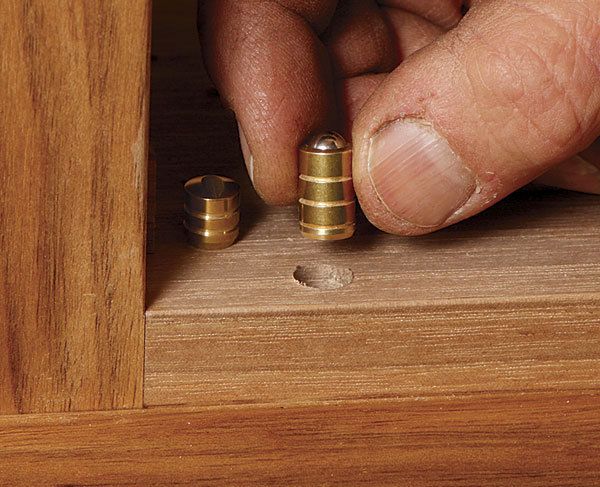Case Closed
How to use off-the-shelf hardware to close cabinet doors in style.
Synopsis: Is a shopmade catch the only tasteful way to keep the doors closed on your cabinets? A quick trip through popular hardware catalogs seems to lend credence to that argument. But three contributing editors—Steve Latta, Garrett Hack, and Michael Fortune—are sharing a few of their secrets for using commercial catches in a way that will look at home on fine furniture. Latta’s favorite is the double-ball catch, which combines versatility, attractiveness, and ease of installation. Hack favors a bullet catch, which he installs at the bottom of the door and is both discrete and practical. Fortune incorporates hidden rare-earth magnets in his cabinets, and also favors using a commercial touch latch, which he hides by making an elegant cover.
From Fine Woodworking #219
Browse through the clunky catches offered in some catalogs and it would be easy to conclude that a shopmade catch is the only tasteful way to keep a cabinet door closed. After all, the goal is a catch that will hold a door securely closed but be unobtrusive.
But some commercial catches are simple and discrete enough to be at home in fine furniture.
In this article, three of our contributing editors show you their techniques for making
elegant use of different commercial catches. We’ll also show you how to make a simple catch
using hidden rare-earth magnets.
Double-ball catch: Adjustable power where it’s needed Among all the contemporary catches I’ve seen, I like the double-ball variety for its versatility, appearance, and ease of installation. And, like the bullet catch, you can even install them when the cabinet back is already in place.
In general, it’s good to place the catch close to where the door pull is located, but because these catches have the ability to pull a door into a frame or against a stop, you can place them selectively to alleviate a slight twist in the door caused by a poor glue-up or wood movement. Place them at the top, bottom, or along the edge—wherever the pressure is needed. I typically use them on inset doors, but they’ve performed well for my students on overlay doors, too. They are relatively attractive as far as hardware goes and, being brass, can be easily antiqued or polished. They are easy to install and easy to adjust. You can adjust the tension spring and, if need be, reshape the tear-drop portion for a smoother feel. The cost is minimal and they are readily available. A note of caution, however: I’ve seen the quality of many of these units decline over the years. I like the versions from Lee Valley and Whitechapel.
Bullet catch: Discrete and supportive I like a catch that holds a door shut and is quiet, gentle, and not obvious. A little bullet catch does all of that, plus, when located at the bottom of the door, keeps it from sagging. These catches hold best if the gap around the door is small, roughly 1⁄16 in.
A bullet catch has two parts: The “bullet” is a compact brass cylinder with a spring-loaded ball bearing at one end. On nicer catches, like those from Brusso or Horton Brasses, the mating “keeper” piece is a shorter cylinder with a slightly convex end that’s indented across the center to capture the ball bearing.
A good place for the catch is centered both on the door’s thickness and on the width of the outer stile. It’s possible to mount the bullet on the underside of the door, but most of the time I put it in the bottom rail of the case, with the keeper in the door, where any wear will be hidden.
For the full article, download the PDF below:
Fine Woodworking Recommended Products

Bessey EKH Trigger Clamps

Dubuque Clamp Works Bar Clamps - 4 pack

Festool DF 500 Q-Set Domino Joiner























Log in or create an account to post a comment.
Sign up Log in